Happy Acupuncture Point
1. Happy point's official name and location:
Happy point ‘s official name is Hall of impression (EX-HN3). It located between the inner eyebrows on Governing (Du) Vessel Meridian. However, “happy point” is not generally considered to be a acupuncture point on Governing (Du) Vessel. “Happy point” is classified as one of the extra points. Happy point is also interesting to note that it lies in the area known as the third eye in various traditional cultures. One of my patients name this point as “Happy point” after her depression and anxiety released by needling this point.
Using infrared detector, we found that the temperature in “happy point” was significantly increased during Qigong. This result suggested Happy point is a important location for meridian function. Meditation can activates improving body wellness.
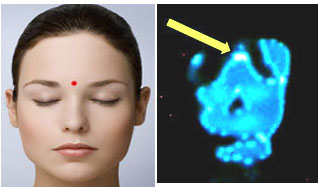
2. Happy point's biological function
Happy point is an anatomically important area in the brain, in where both of pituitary gland and pineal gland are located. Many researches have showed that acupuncture can increase the hormones secreting in both pineal and pituitary glands.
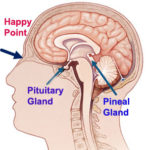
The pituitary gland secretes many important hormones to control growth, blood pressure, sex, pregnancy, childbirth, nursing, function of kidneys, temperature, and pain relief. Pituitary gland also regulates immune system through adrenal gland, lymph node and growth hormone. So stimulating happy point by acupuncture can improve body’s functions including immune function.
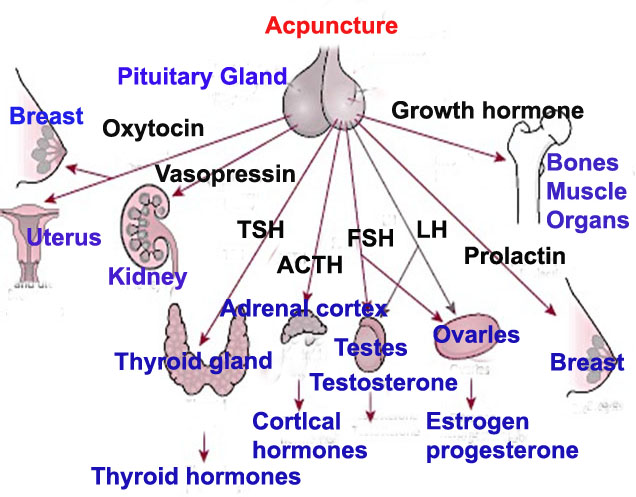

Research confirmed acupuncture happy point can activate pituitary gland. Using functional MRI (fMRI) investigated cerebral functional regions after stimulating Happy point by electroacupuncture. Statistical parametric mapping for regional homogeneity (ReHo) and amplitude of low-frequency fluctuation (ALFF) were analyzed. Results showed both ReHo and ALFF were increased after 5 and 15 post stimulations on temporal lobe area. Because pituitary gland locate in temporal lobe area in the brain, acupuncture happy point activated pituitary gland. .
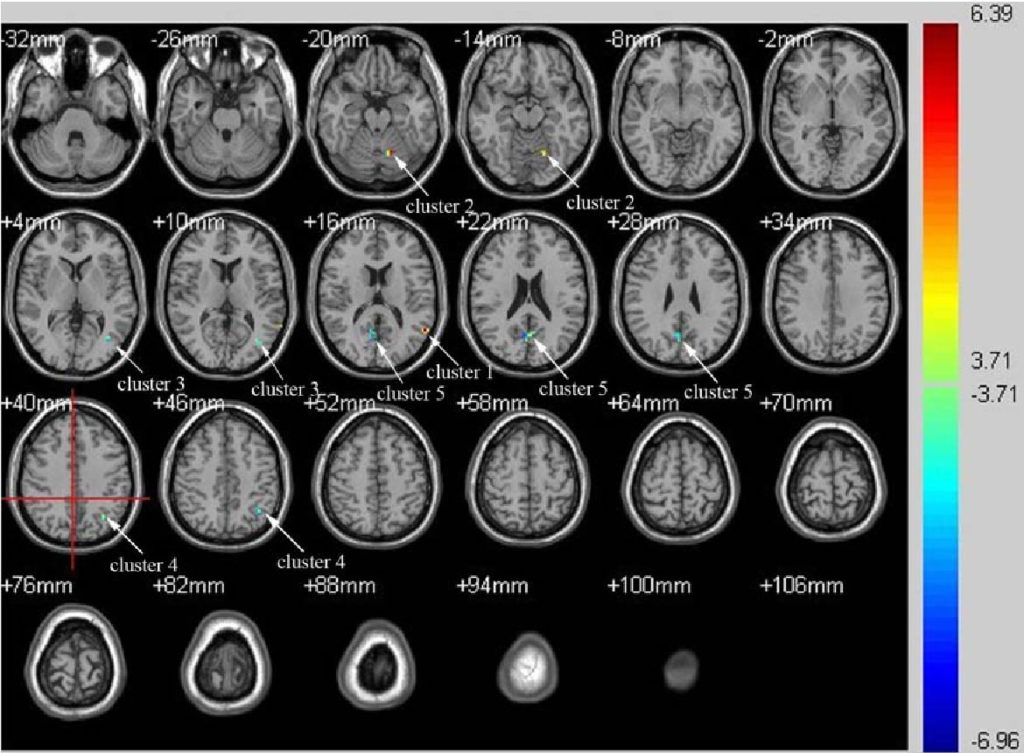
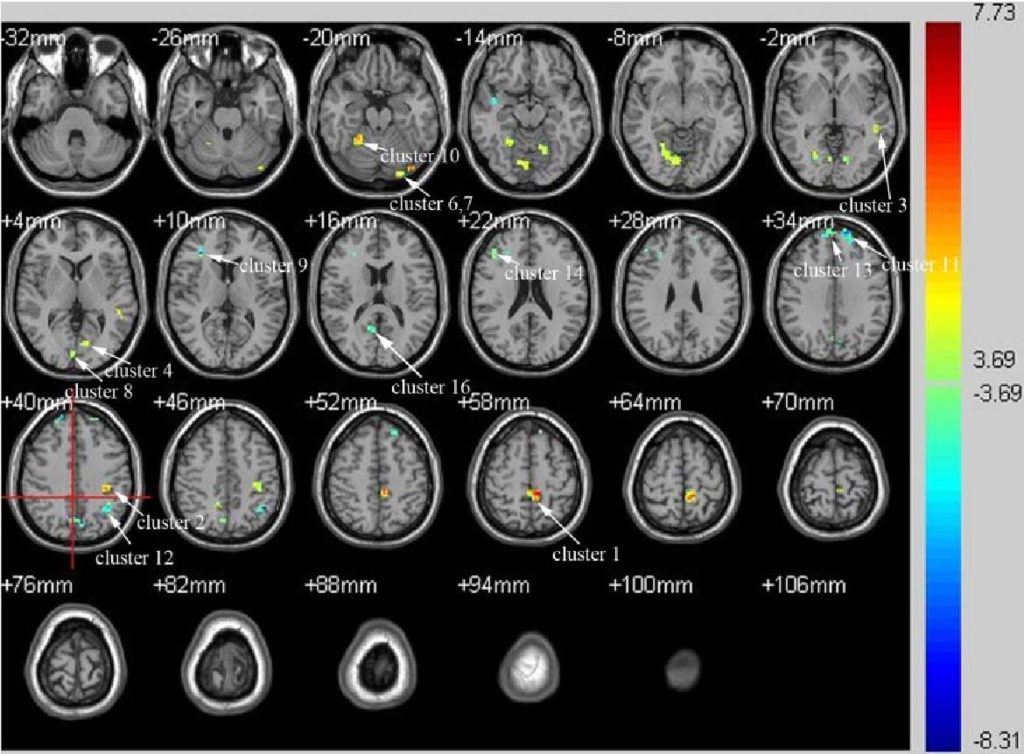
3. Clinic study for effect of happy points on anxiety and insomnia
(1) Happy point for anxiety
A 2018 preliminary review conducted by Chan-Young Kwon et al reported to the current state of studies using happy point (EX-HN 3) alone for anxiety. Five clinic trials including 366 patients were included in the review. The conclusion is that acupuncture on happy point (EX-HN 3) alone reduces the anxiety of preoperative participants.
Pre-operative anxiety is an unpleasant state of psychological distress that occurs in up to 87% of patients awaiting neurosurgical procedures. A single-center, prospective, randomized controlled trial was designed to determine the effect of acupuncture at the happy point (EX-HN3) on pre-operative anxiety levels in neurosurgical patients. 128 patients were involved in this study. The patients receive either acupuncture at the happy point (EX-HN3) point (acupuncture group) or no intervention (control group). The anxiety level was measured by using six-item short form of the State-Trait Anxiety Inventory. The results showed that Anxiety Inventory score reduced significantly in the acupuncture group with no change seen in the control group. There were no adverse events in either group. This result suggested acupuncture at the happy point (EX-HN3) reduces pre-operative anxiety levels in patients awaiting neurosurgery.
An animal study aimed to determine if mechanism of acupuncture for depression found that acupuncture happy point (EX-HN3) and Baihui (CV20) significantly decreased depress measured by immobility in swimming test, sucrose preference test and open field test, compared with the Sham acupuncture. The expression of 5-HT, a monoamine neurotransmitter that plays an important role in sleep, feeding, mood disorders, anxiety disorders et al, was significantly decrease in the hippocampus CA1regionn, comparison to the sham acupuncture group. The result suggested acupuncture happy point (EX-HN3) and Baihui (CV20) together could ameliorate depressive-like behaviors by restoring hippocampus CA1 synaptic plasticity.
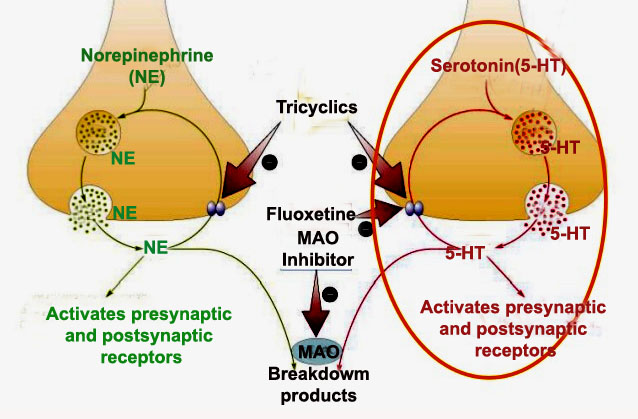
(2) Happy point for insomnia
A randomized, single-blind, placebo-controlled, clinic trial parallel-group investigated the efficacy and safety of electroacupuncture for the treatment of primary insomnia. 60 adult volunteers who report having insomnia 3 or more nights per week for at least 3 months. Their symptoms meet the DSM-IV criteria for primary insomnia and an Insomnia Severity Index total score of at least 15. Electroacupuncture points include Happy point (EX-HN3), additional to other points. The experiment groups received 3 times per week for 3 weeks. Control group received placebo acupuncture using Streitberger needles at the same points. The results showed that there were significantly greater improvements in sleep efficiency by sleep diary and actigraphy in the electroacupuncture group. The proportions of subjects having less than 30 minutes of wake after sleep onset and a sleep efficiency of at least 85% at the posttreatment visit were significantly higher in the electroacupuncture group. All adverse events were mild in severity
4. Reference
1. Zheng Y, Qu S, Wang N, Liu L, Zhang G, Jiang X, Chen J, Huang Y, Zhang Z. Post-stimulation effect of electroacupuncture at Yintang (EX-HN3) and GV20 on cerebral functional regions in healthy volunteers: a resting functional MRI study.Acupunct Med. 2012 Dec;30(4):307-15
2. Chan-Young Kwon 1 2, Boram Lee, Acupuncture or Acupressure on Yintang (EX-HN 3) for Anxiety: A Preliminary Review, Med Acupunct 2018 Apr 1;30(2):73-79
3.Wing-Fai Yeung , Ka-Fai Chung, Shi-Ping Zhang, Tuan-Gee Yap, Andrew C K Law, Electroacupuncture for Primary Insomnia: A Randomized Controlled Trial, Sleep, 2009 Aug;32(8):1039-47
4.Xuke Han , Huangan Wu , Ping Yin , Zeqin Chen , Xiaohua Cao , Yanhong Duan , Jian Xu , Lixing Lao , Shifen Xu, Electroacupuncture Restores Hippocampal Synaptic Plasticity via Modulation of 5-HT Receptors in a Rat Model of Depression, Brain Res Bull, 2018 May;139:256-262
5. Ken Takagi, Nobuyuki Tanahashi, Nozomi Amagasu, Kaito Mizuno, Jun Kawanokuchi, Guo Yi, Torao Ishida, Effect of Manual Acupuncture Stimulation at "Bai-Hui" (GV 20) or "Yintáng" (Ex-HN3) on Depressed Rats, J Acupunct Meridian Stud, 2017 Jan;10(1):26-32.
6. Jian Xu, Yanling She, Ning Su, Ruixin Zhang, Lixing Lao, Shifen Xu, Effects of Electroacupuncture on Chronic Unpredictable Mild Stress Rats Depression-Like Behavior and Expression of p-ERK/ERK and p-P38/P38, Evid Based Complement Alternat Med, 2015;2015:650729
7.Ju-Young Oh, Yu-Kang Kim, Seung-Nam Kim , Bombi Lee , Jae-Hwan Jang, Sunoh Kwon, Hi-Joon Park,Acupuncture Modulates Stress Response by the mTOR Signaling Pathway in a Rat Post-Traumatic Stress Disorder Model, Sci Rep 2018 Aug 8;8(1):11864

